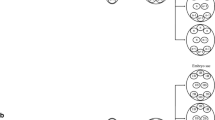Summary
The B 9 chromosome of maize exhibits a very ordered type of instability at the second pollen mitosis, when nondisjunction may reach a level of 95%. Much less commonly the chromosome is unstable during early development of the kernel. Instability in the kernel produces recessive sectors in either the endosperm or the sporophyte, reflecting the absence of dominant markers carried by the B 9. The causes of B 9 loss in the endosperm and the sporophyte were investigated for the two observable classes of sectoring: fractional loss (single event) and multiple loss (mosaic pattern). The fractional class represents isochromosome formation by the B 9 (Carlson, 1970, 1971). Data presented here suggest that the isochromosome is a by-product of telocentric formation at the second pollen mitosis, and does not arise directly from the B 9 chromosome. The chromosomal basis for the mosaic pattern of B 9 loss is not completely known. However, one class of mosaic kernels displays a heritable instability of the B 9 chromosome which apparently results from ring chromosome formation by the B 9. The time of origin of the ring B 9 chromosome is prior to the second pollen mitosis, since the unstable chromosome generated in the male parent is transmitted to both the endosperm and the sporophyte. Finally, a genetic factor controlling B 9 stability in the developing endosperm has been found. A single plant (1818-1), crossed as a female parent to a B 9-containing stock, induced a mosaic pattern of B 9 loss in the endosperm at a very high rate. The characteristics of this plant are being investigated.
Similar content being viewed by others
Literature
Bianchi, A., Bellini, G., Contin, M., Ottaviano, E.: Nondisjunction in presence of interchanges involving B-type chromosomes in maize and some phenotypical consequences of meaning in maize breeding. Z. Vererbungslehre 92, 213–232 (1961).
Carlson, W.: Factors affecting preferential fertilization in maize. Genetics 62, 543–554 (1969a).
Carlson, W.: A test of homology between the B chromosome of maize and abnormal chromosome 10, involving the control of nondisjunction in B's. Mol. Gen. Genetics 104, 59–65 (1969b).
Carlson, W.: Nondisjunction and isochromosome formation in the B chromosome of maize. Chromosoma 30, 356–365 (1970).
Carlson, W.: A survey of B9 instability in the sporophyte. Maize Gen. Coop. News Letter 45, 70–73 (1971).
Darlington, C. D.: Misdivision and the genetics of the centromere. Jour. Genet. 37, 341–364 (1939).
Darlington, C. D.: The origin of isochromosomes. Jour. Genet. 39, 351–361 (1940).
Ghidoni, A.: Transmission and phenotypic effect of a duplicate chromosome segment in maize. Mol. Gen. Genetics 101, 317–332 (1968).
Longley, A. E.: The origin of diminutive B-type chromosomes in maize. Am. Jour. Bot. 43, 18–22 (1956).
McClintock, B.: The production of homozygous deficient tissues with mutant characteristics by means of the aberrant mitotic behavior of ring chromosomes. Genetics 23, 315–376 (1938).
McClintock, B.: The association of mutants with homozygous deficiencies in Zea mays. Genetics 26, 542–571 (1941a).
McClintock, B.: Spontaneous alterations in chromosome size and form in Zea mays. Cold Spring Harbor Symp. Quant. Biol. 9, 72–81 (1941b).
Rhoades, M. M.: Studies of a telocentric chromosome in maize with reference to the stability of the centromere. Genetics 25, 483–520 (1940).
Robertson, D. S.: Crossing over and chromosomal segregation involving the B 9 element of the A—B Translocation B-9 b in maize. Genetics 55, 433–449 (1967).
Roman, H.: Mitotic nondisjunction in the case of interchanges involving the B-type chromosome in maize. Genetics 32, 391–409 (1947).
Roman, H.: Directed fertilization in maize. Proc. Natl. Acad. Sci. 34, 36–42 (1948).
Roman, H.: Factors affecting mitotic nondisj unction in maize (Abstract). Genetics 35, 132–133 (1950).
Ward, E.: Effects of various segments of the B chromosome on recombination and nondisjunction. Maize Gen. Coop. News Letter 46, 53–59 (1972).
Author information
Authors and Affiliations
Additional information
Dedicated with much appreciation and respect to Dr. M. M. Rhoades on the occasion of his 70th birthday.
Rights and permissions
About this article
Cite this article
Carlson, W.R. Instability of the maize B chromosome. Theoret. Appl. Genetics 43, 147–150 (1973). https://doi.org/10.1007/BF00306564
Received:
Issue Date:
DOI: https://doi.org/10.1007/BF00306564




